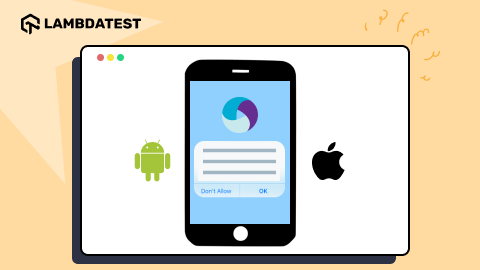Mobile Responsive Design: Step-by-Step Guide
Zikra Mohammadi
Posted On: November 19, 2024
![]() 41848 Views
41848 Views
![]() 13 Min Read
13 Min Read
With the rise of smartphones and tablets, mobile responsive design has become essential for websites. This approach ensures that your website functions as expected on any screen size, from mobile devices, tablets and desktops.
Since users expect a seamless experience, businesses need to prioritize responsive design to engage visitors and enhance their mobile web experience.
In this tutorial, let’s look at what mobile responsive design is and why it matters. We will also explore how to build responsive websites along with best practices.
TABLE OF CONTENTS
- What Is Mobile Responsive Design?
- Why Is Mobile Responsiveness Important?
- How to Build Mobile Responsive Designs?
- Key Factors to Consider for Mobile Responsive Design
- How to Test Mobile Responsive Designs?
- Best Practices for Creating Mobile Responsive Designs
- Differences: Mobile-Friendly Designs vs Responsive Designs
- Frequently Asked Questions (FAQs)
What Is Mobile Responsive Design?
Mobile responsive design is a concept that involves adapting web pages automatically depending on the screen size. It means that whether viewed from a desktop, tablet, or smartphone, the website will adjust its layout, text, and images to fit the screen size and orientation.
The objective of mobile responsive design is to provide a consistent and seamless user experience when accessing websites on different screen sizes and resolutions.
Ensuring that websites are mobile responsive not only helps retain users and increase engagement but also benefits search engine rankings. Responsive design is favored by search engines like Google, positively impacting both visibility and traffic.
Check out this guide to learn more about responsive design.
Why Is Mobile Responsiveness Important?
Mobile responsiveness is critical for a successful web presence. With increasing visitors accessing websites via mobile devices, it is vital that your site instantly adjusts to different screen sizes.
Let’s see the importance of creating a mobile responsive design:
- Mobile Dominance: Mobiles are now responsible for about half of all web traffic, and the trend is still growing. That means a huge segment of your audience is checking out your website on either smartphones or tablets. If your website is not optimized for mobile viewing, you risk losing a large proportion of visitors who abandon it for poor usability.
- Better UX: A user experience is one major thing that keeps people around your website and makes them explore further into your content. If your web design is mobile responsive, then the content gets to adjust on different sizes of screens so that you don’t need to zoom in and scroll horizontally across the website.
- Increased Conversion Rates: Conversion rates indicate how well your website converts visitors into customers. Mobile responsiveness boosts conversion rates by optimizing forms, call-to-action buttons, and other interactive features for mobile devices. Users are more likely to accomplish desired actions on your website if the experience is smooth and without hassle.
- Competitive Edge: In the digital world, the seamless user experience can make or break a brand’s reputation. Having a mobile responsive website differentiates your business from those who haven’t invested in optimizing mobile websites.
- Accessibility and Inclusivity: Mobile responsiveness improves accessibility by making your website usable for a wider range of users, including those with impairments. A responsive design frequently incorporates accessibility best practices like large fonts, easier navigation, and touch-friendly features.
Also, it makes UX more appealing to users, leading to users staying for longer times with your website.
It makes it easier for those with visual or motor impairments to interact with your website, broadening your audience and displaying your dedication to inclusivity.
 Note
NoteTest responsive designs across 3000+ real mobile browsers. Try LambdaTest Today!
How to Build Mobile Responsive Designs?
Here is how to build mobile responsive designs focusing on user engagement, functionality and accessibility.
- Understand Your Audience and Define Breakpoints: Begin by exploring user data to determine the most popular devices and screen sizes among your target audience. This insight helps in the setting up of breakpoints, which serve as responsive design markers for various screen widths, ensuring that your design is adaptive.
Typical breakpoints are 320px for small mobile devices, 768px for tablets, and 1024px for desktops. Defining these breakpoints allows your layout to shift fluidly across common devices, making your site more accessible to a varied audience.
For more information, check out this blog on CSS breakpoints.
- Use a Fluid Grid System: A fluid grid system is required to make your design layout flexible to various screen sizes. Rather than using fixed pixel widths, use percentage-based widths to build a more flexible structure.
It lets each element resize appropriately to the user’s screen, ensuring uniformity across devices. Designing with fluid grids ensures that content automatically changes to fit any screen, resulting in a cohesive and legible experience.
- Make Images Responsive: Images should scale smoothly to avoid unwanted resizing or loss of quality across different devices. Use CSS attributes such as max-width: 100% to make images adjust to the size of their container.
Furthermore, Scalable Vector Graphics (SVGs) are ideal for logos and icons since they retain quality at all sizes. Implementing responsive graphics improves visual consistency and reduces loading times for mobile devices.
For more details, refer to this blog on responsive images in CSS.
- Set Up Flexible Typography: Typography should be easy to read on both large and small displays. Avoid using fixed font sizes and instead, use responsive units like em or rem to scale text size based on the viewport. It ensures that content is legible on all devices without having the user zoom or scroll horizontally. Flexible typography increases readability and enhances the user experience.
Read this blog to learn more about CSS typography.
- Optimize for Touchscreen Navigation: Make sure that navigation and clickable elements are straightforward to use with a touch interface. Create correctly sized buttons, links, and dropdowns that are spaced apart for simple tapping. Consider the “thumb zone” — the area where users may easily reach with their thumbs — to increase engagement on handheld devices. This strategy reduces frustration and improves touchscreen usage.
- Use Media Queries to Adapt Styles: Media queries enable you to customize styles based on specified breakpoints, such as device width or orientation. They allow you to customize layouts, font sizes, and other design aspects for various screens. For example, you can hide secondary content or reorganize components to fit smaller screens. Media queries give flexibility to your design, allowing it to adapt to different screen sizes.
For more details, head over to this blog on CSS media queries.
- Prioritize Content Loading for Mobile Devices: To improve mobile performance, load important elements first. Lazy loading lets images and other heavy elements load only when they are visible, which reduces initial load time. Compress images, use optimized file formats, and limit the use of huge files to provide a faster, more efficient experience for mobile users.
Key Factors to Consider for Mobile Responsive Designs
A mobile responsive design involves careful consideration of features that improve usability, readability, and performance on smaller displays. With mobile users accounting for a sizable amount of web traffic, making sure your web design works well across devices is critical to offering a smooth user experience.
Here are some important factors to consider when designing an effective mobile responsive website:
- Readability: A fundamental part of mobile responsiveness is keeping text readable without the need for zooming or scrolling. Rather than simply downsizing the desktop version of the text, optimize font sizes and spacing for smaller devices. Proper formatting and enlargement of important texts ensure a smooth reading experience on mobile devices.
- Image and Button Sizes: Mobile users want buttons and visuals to be simple to engage with. To avoid unpleasant experiences, create buttons that are large, well-spaced, and easy to click. Images should be optimized for mobile by reducing file sizes and ensuring responsiveness so that they can adjust to screen dimensions without distorting or slowing page loading.
- View Orientation: Users regularly switch between portrait and landscape orientations on mobile devices. Responsive web design should account for this by ensuring that content and images retain their layout integrity in both orientations, hence avoiding display challenges. A responsive layout ensures that the web page is functional and visually appealing regardless of how users interact with it.
- Lightweight Design: Mobile users have limited patience, especially when a website takes too long to load. To maximize responsiveness, websites should have a lightweight design with few resource-intensive components.
Image size reduction, file compression, and code optimization can all help to speed up load times. A speedier, smoother experience not only retains users but also creates a positive impression, improving the likelihood of return visits and interaction.
Now, in the next section, let’s take a look at how to perform responsive testing of your mobile websites.
How to Test Mobile Responsive Designs?
To test mobile responsive designs, various responsive checkers (or tools) are available to speed up the process. These tools not only make it easier to evaluate how a website works across different devices and screen sizes, but they also improve test accuracy and efficiency. One such tool is LT Browser by LambdaTest.
LT Browser is a developer-friendly browser to test mobile responsiveness on various screen sizes. It simplifies running mobile-friendly tests across various device viewports for mobile, tablet, desktop and laptop.
To test your websites for mobile responsiveness on LT Browser, follow these steps:
- Launch LT Browser.
- Choose from a wide range of pre-configured device viewports or add a custom device for testing.
- Input the URL of the website you want to test in the address bar.
You can now check how your website adapts to different screen sizes and resolutions by switching between device viewports.

Features:
- Instant Access to Multiple Device Viewports: It provides over 50 pre-built device viewports, including popular mobile, tablet, desktop, and laptop screen sizes.
- Side-by-Side View Testing: It offers dual-screen functionality that enables you to test the website on two devices side-by-side, making it easy to spot differences and verify consistent design elements.
- Live-Interactive Testing with DevTools: It comes with built-in developer tools to inspect and debug issues on the spot.
- Network Throttling: It lets you test the website speed under different network conditions, such as 3G, 4G, 5G or offline.
To know how to leverage other features, refer to this guide on getting started with LT Browser.
Best Practices for Creating Mobile Responsive Designs
Here are some best practices that can help you in the effective designing of mobile responsive designs:
- Design Using a Mobile-First Approach: Adopt a mobile-first strategy, starting with the smallest screen sizes and then expanding up. This strategy promotes simplicity and usefulness while prioritizing key features for mobile users. As you expand to larger screens, you may gradually introduce more complicated pieces without overloading the layout.
- Leverage CSS Media Queries: Use CSS media queries for designing responsive designs. Use them to adapt your website’s appearance at various breakpoints, allowing for changes in layout, font sizes, and spacing based on device screen size. Media queries enable the flexibility required to deliver a personalized experience, ensuring that your content is shown optimally independent of the user’s device.
- Prioritize Content Hierarchy: When designing for mobile, it is critical to organize your content. Begin by selecting and presenting the most important information for users. It can have critical components such as navigation links, calls to action, and key messages. By prioritizing material in this manner, you can reduce the need for excessive scrolling and allow visitors to reach critical information quickly and easily.
- Optimize Navigation for Mobile Use: Provide collapsible menus like the hamburger menu that reduce the size of the navigation while still allowing a user to tap on the icon and open multiple options in one go. Also, provide the minimum number of menu items for viewing to avoid clutter and confusion.
- Use SVG: Use SVGs wherever possible instead of the common image formats like JPEG or PNG. SVGs are resolution-independent and, therefore, look perfect at every size, making them ideal for responsive designs. Furthermore, SVGs often have reduced file sizes, which might result in faster load times.
- Test on Real Devices: Run tests on real devices to provide a consistent user experience in real-world conditions. Testing on different devices and their OS versions allows you to assess how the design performs and make any necessary changes before launching the website.
- Minimize Popups and Interstitials: Popups can hinder your mobile experience. Therefore, avoid using popups and interstitials that hide content, as they may cause users to leave your website.
Check out this blog to learn more about mobile-first design.
You can also leverage AI-powered testing platforms such as LambdaTest that offer a real device cloud to test mobile websites across 5000+ real Android and iOS devices.
Differences: Mobile Responsive Designs vs Mobile-Friendly Designs
Knowing the difference between mobile-friendly and mobile responsive designs is crucial to developers and testers. Although both techniques improve usability on a mobile device, they are in different strategies and concepts.
| Aspects | Mobile Responsive Designs | Mobile-Friendly Designs |
|---|---|---|
| Design | Adapts dynamically to screen size and orientation for a consistent experience on all devices. | Creates a separate, simplified version tailored for mobile devices. |
| User Experience | Ensures smooth, user-centered navigation and accessibility across all devices. | May cause user confusion due to redirects and inconsistencies with navigation and functionality. |
| Maintenance | Uses a single, unified site that simplifies updates and maintenance, reducing costs. | Requires maintaining two separate versions, increasing costs and complexity. |
| SEO | Enhances SEO with a single URL structure, better crawlability, and lower bounce rates, improving search engine performance. | Can impact SEO with indexing issues and duplicate content across mobile and desktop versions. |
Conclusion
In summary, mobile responsive design is essential for effective web development, ensuring that websites adapt seamlessly across all devices. For businesses, prioritizing responsive design keeps customers engaged and satisfied. Using techniques like fluid grids, flexible images, and streamlined navigation not only improves user experience but also boosts search engine rankings and increases traffic.
Frequently Asked Questions (FAQs)
What does it mean for an application to be mobile responsive?
A mobile responsive application adjusts its layout and elements to provide an optimal viewing experience across different screen sizes and devices. It uses flexible grids and media queries to ensure content is accessible and visually appealing on all platforms.
What is mobile responsive vs native?
Mobile responsive websites adapt to various screen sizes and devices through a single codebase, providing a consistent user experience. Native applications, on the other hand, are built specifically for a platform (iOS, Android) and offer better performance and access to device features.
Got Questions? Drop them on LambdaTest Community. Visit now
















